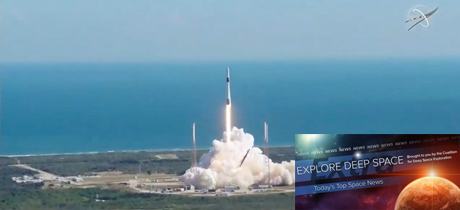In Today’s Deep Space Extra… NASA Administrator Jim Bridenstine calls on Congress to pass NASA’s 2020 budget. Russia, SpaceX launch back to back cargo missions to the International Space Station (ISS). University of Alabama in Huntsville assesses space nuclear propulsion option for Mars missions.
Human Space Exploration
Bridenstine implores Congress to finalize 2020 appropriations for desperately needed HLS
Spacepolicyonline.com (12/6): If NASA is to accomplish an accelerated human return to the surface of the Moon in 2024, Congress needs to complete an already overdue 2020 fiscal year budget, NASA Administrator Jim Bridenstine said in a Washington Capitol Hill presentation before the Space Transportation Association. The fiscal year began October 1. NASA and other federal agencies are operating under a second budget continuing resolution that expires December 20 and restricts spending to 2019 levels. Without a 2020 budget, NASA cannot pursue a commercial Human Landing System partnership for the rocketry to achieve the 2024 human lunar return goal established by the White House earlier this year, said Bridenstine.
Russian cargo craft launches toward Space Station
Space.com (12/6): A Russian Progress cargo capsule bound for the International Space Station (ISS) launched early Friday atop a Russian Soyuz 2a.1 rocket from the Baikonur Cosmodrome in Kazakhstan. The 4:34 a.m., EST, liftoff placed the Progress and its 5,571 pound cargo on course to reach the six person Space Station early Monday.
Falcon 9 launches Dragon cargo spacecraft to ISS
SpaceNews.com (12/5): SpaceX’s 19th NASA contracted cargo mission to the International Space Station (ISS) lifted off Thursday from Cape Canaveral, Florida. The commercial space freighter is to arrive at the six person Space Station early Sunday with 5,700 pounds of cargo.
Astronauts are going to attach a “robot hotel” to the outside of the International Space Station
Universe Today (12/5): Robotic devices are finding an increasing presence on the International Space Station (ISS) as researchers and astronauts evaluate how they might play critical roles in the future human exploration of the Moon and Mars. NASA’s Johnson Space Center (JSC) and Goddard Space Flight Center have joined to provide external robots with a place to park outside the orbiting science lab when they are not in use. The Robotic Tool Stowage is among cargoes launched to the Station aboard a SpaceX Dragon resupply mission on Thursday.
UAH studies nuclear ride to Mars
Business Alabama (12/5): Researchers at the University of Alabama in Huntsville (UAH) are working with NASA’s Marshall Space Flight Center to assess a nuclear propulsion strategy for Mars missions. A nuclear reactor would work with a rocket engine to increase fuel efficiency. But the concept includes significant technical challenges.
Space Science
Eruptions on asteroid Bennu hint at causes of space rock explosions
Space.com (12/5): NASA’s Osiris-Rex asteroid sample return mission to distant Bennu is providing insights into the behavior of near Earth asteroids, or primitive planetary bodies that cross the orbital plane of the planet Earth. While mission managers near the conclusion of a landing site selection process, they have also developed plausible explanations for eruptions of debris on the surface of Bennu. Regular cycles of solar heating of the asteroid’s rock strewn surface may be responsible.
Evidence of an alien planet spotted around a white dwarf, a cosmic first
Space.com (12/4): A recent study points to the possibility of an extra solar planet orbiting a white dwarf star. Many stars, including those like our sun, will end up as white dwarfs as they age. Researchers from the University of Warwick, of England, led the study.
Op Eds
Envisioning the next 50 years in space
SpaceNews.com (12/5): A range of factors are coming together to push human exploration into deep space over the next five decades, according to an assessment from Dylan Taylor, chair of Voyager Space Holdings and a co-founding member of the Commercial Space Flight Federation. Those include new technologies and commercial investment as well as government support for returning to the surface of the moon and pressing on to Mars. Finding and exploiting resources on the Moon and Mars, among them water ice, will help to sustain the drive in ways not possible with NASA’s Apollo era lunar missions, he writes.
Other News
Electron launches smallsats in test of rocket reusability
SpaceNews.com (12/6): Rocket Lab successfully launched several smallsats December 6 on an Electron mission also designed to test technologies to make the rocket’s first stage reusable. The Electron lifted off from the company’s launch site on New Zealand’s Mahia Peninsula at 3:18 a.m. EST after more than a week of delays caused by ground equipment issues and weather. The rocket’s Curie kick stage deployed its payload of seven smallsats starting about an hour after liftoff.

